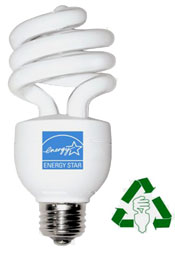 Being earth-friendly doesn't require going solar or growing all your own food. There are plenty of easy ways to make a big difference.
Being earth-friendly doesn't require going solar or growing all your own food. There are plenty of easy ways to make a big difference.
- By Ann Archer
When it comes to the environment, being a good global citizen starts at your doorstep. From recycling to using alternative cleaning materials, minor changes at home can add up to real benefits for the planet, not to mention your own health and happiness.
It may be a cliché, but the best way to be Earth-friendly is to cut down on what you consume and recycle whenever you can. The U.S. generates about 208 million tons of municipal solid waste a year, according to the National Institutes of Health. That's more than 4 pounds per person per day. Every little bit helps; recycling just one glass bottle saves enough electricity to light a 100-watt bulb for four hours.
Here are 10 easy ways to green your home...
1. Green up your appliances
Getting rid of that old refrigerator in the garage could save you as much as $150 a year, according to the Environmental Protection Agency. Appliance use comprises about 18% of a typical home's total energy bill, with the fridge being one of the biggest energy hogs. If any of your appliances is more than 10 years old, the EPA suggests replacing them with energy-efficient models that bear their "Energy Star" logo. Energy Star-qualified appliances use 10%-50% less energy and water than standard models. According to the Energy Star site, if just one in 10 homes used energy-efficient appliances, it would be equivalent to planting 1.7 million new acres of trees.
Also, consider what you put in that energy-efficient refrigerator. Pesticides, transportation and packaging are all things to consider when stocking up. Buying local cuts down on the fossil fuels burned to get the food to you while organic foods are produced without potentially harmful pesticides and fertilizers.
2. Watch the Temp
 Almost half a home's energy consumption is due to heating and cooling. Turn down the thermostat in cold weather and keep it higher in warm weather. Each degree below 68°F (20°C) during colder weather saves 3%-5% more heating energy, while keeping your thermostat at 78°F in warmer weather will save you energy and money. A programmable thermostat will make these temperature changes for you automatically.
Almost half a home's energy consumption is due to heating and cooling. Turn down the thermostat in cold weather and keep it higher in warm weather. Each degree below 68°F (20°C) during colder weather saves 3%-5% more heating energy, while keeping your thermostat at 78°F in warmer weather will save you energy and money. A programmable thermostat will make these temperature changes for you automatically.+ Clean your furnace's air filter monthly during heavy usage.
+ Consider a new furnace. Today's furnaces are about 25% more efficient than they were in the 1980s. (And don't forget to check out furnaces carrying the Energy Star label.) + To keep your cool in warmer weather, shade your east and west windows and delay heat-generating activities such as dishwashing until evening.
+ Use ceiling fans instead of air conditioners. Light clothing in summer is typically comfortable between 72°F and 78°F. But moving air feels cooler, so a slow-moving fan easily can extend the comfort range to 82°F, according to "Consumer Guide to Home Energy Savings" by Alex Wilson.
3. Save Water
The Web site "Water - Use It Wisely", created by a group of Arizona cities, lists 100 simple ways to save water. We'll share just a few here:+ Put an aerator on all household faucets and cut your annual water consumption by 50%.
+ Install a low-flow toilet. They use only 1.6 gallons per flush, compared to 3.5 gallons per flush for pre-1994 models. If you have an older model, adjust your float valve to admit less water into the toilet's tank.
Of course, you don't need products to save water -- behavioral changes also add up quickly: using a broom instead of the garden hose to clean your driveway can save 80 gallons of water and turning the water off when you brush your teeth will save 4.5 gallons each time.
4. Clean Green
Stop buying household cleaners that are potentially toxic to both you and the environment. In his book, "The Safe Shopper's Bible," David Steinman suggests reading labels for specific, eco-friendly ingredients that also perform effectively.These include grain alcohol instead of toxic butyl cellosolve, commonly found in carpet cleaner and some window cleaners as a solvent; coconut or other plant oils rather than petroleum in detergents; and plant-oil disinfectants such as eucalyptus, rosemary or sage rather than triclosan, an antifungal agent found in soaps and deodorant.
Or, skip buying altogether and make your own cleaning products. Use simple ingredients such as plain soap, water, baking soda (sodium bicarbonate), vinegar, washing soda (sodium carbonate), lemon juice and borax and save money at the same time.
Check out these books by Annie Bertold-Bond for cleaning recipes: "Clean and Green" and "Better Basics for the Home."
5. Let there be Energy-efficient Light
Compact Fluorescent Light bulbs (CFLs) use 66% less energy than a standard incandescent bulb and last up to 10 times longer. Replacing a 100-watt incandescent bulb with a 32-watt CFL can save $30 in energy costs over the life of the bulb.This is, as they say, a "no-brainer!"
Green Your Home steps 6-10



